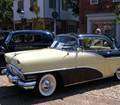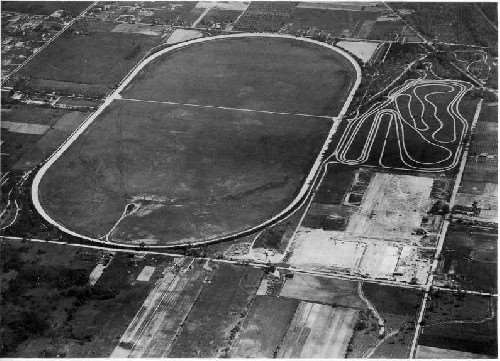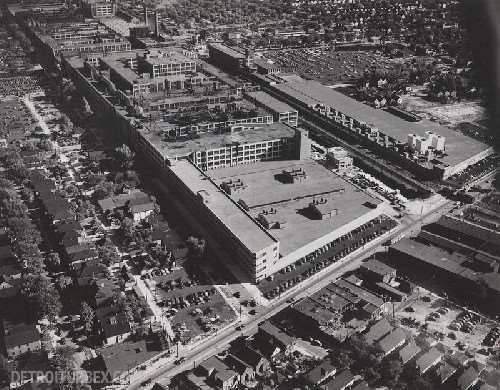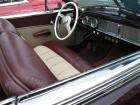|
Re: One Story Assembly Plant What If?
|
||||
|---|---|---|---|---|
|
Home away from home

|
I don't see any inherent defect in a multi-story manufacturing plant.
The multistory plants were favored when gravity feed was used to move parts downward toward the assembly line. When electric conveyors became common, gravity feed was no longer needed. And, of course, a multistory plant presents the problem of getting the parts to the upper floors in the first place. I have seen photos of the inside of Ford Highland Park and Studebaker in South Bend, where rail cars of material were brought into the center of the building and an overhead crane was used to lift the material to a number of balconies on the upper floors. A material handling nightmare compared to plants today. The Packard plant had no rail access There is a spur from the mainline running south, past the west side of the Packard foundry, across Harper and the freeway, between the Merlin buildings, across East Grand and on south a couple blocks beyond the south end of the Packard complex. That track is still there today. In the photo, you can see a boxcar crossing Harper. Conner was a terrible compromise Yes, but it was the only thing available on short notice, which made missing the opportunity on Willow Run such a costly mistake.
Posted on: 2014/5/14 21:28
|
|||
|
||||
|
Re: One Story Assembly Plant What If?
|
||||
|---|---|---|---|---|
|
Home away from home

|
This has been a fascinating and informative exercise that shows the interest and knowledge of forum members who share a passion for these cars. Having read the details of the Ward book and the ever so interesting Kimes compendium, the inadequacies of the Conner Street plant was a big contributor to the demise of the Detroit-era of Packard. Production capacity fell to only 25% of the EGB plant and the quality of the first few months of 55 products suffered dramatically. Any efficiencies caused by local body assembly was cancelled out by trucking and supply deficiencies. That drop in supply of the new V-8 cars, just when the public wanted them, was quickly followed by the quality problems and recalls, making the once interested buyers turn away. All told, an excellent product was beset by quality, supply and very bad timing.
Poor Mr. Nance gets too much blame for what happened during his watch, IMHO. Both the Ward and Kimes books make that clear. Packard died because of factors far beyond their control (the Korean conflict ended, Defense contracts either ended or were steered away by Mr. Wilson's Defense Department, people like George Mason and Walter Briggs died and with them a different possible series of legacies, and the crushing blow of overproduction and underpricing of GM and Ford in their sales battles). But surely some of the death was also caused by Packard brains. Particularly the false efficiency claims of Ray Powers (Packard's Production Manager) for the move to Conner, the animousity between Nance and Romney, and that uncertainty as to who owned or controlled the body-making equipment that could have been moved back to EGB. Finally, the lack of accounting due diligence in the Studebaker merger was the final financial nail in the S-P coffin. A perfect storm and a fine company died. Had Mason lived to see a Big Four combination of Packard, Hudson (both using the EGB facility for the high end cars), Nash (staying in Kenosha for Ramblers in the middle), and Studebaker for low priced cars and trucks, the brand might have lasted another 10-20 years longer. But that's really optimistic hindsight. In 20-30 years, our grandchildren might be speculating over "who made Pontiac, Oldsmobile and Plymouth?". Right now, I force myself to not say "Hewlett" when I am asked by a young person about my Packard. It would be too easy to do, but so wrong to obscure a tragedy of the death spiral of a company we love to have loved.
Posted on: 2014/5/15 7:11
|
|||
|
||||
|
Re: One Story Assembly Plant What If?
|
||||
|---|---|---|---|---|
|
Home away from home

|
Dave:
I agree almost 100% with what you have asserted. Independents today (with the exception of Porsche) are generally low-number producers of exclusive, expensive cars. Those independents who tried to build and sell medium-priced higher-number production cars, such as DeLorean, exist for a short time and inevitably disappear. This was true in the past century as well, and that Packard, Studebaker, and a few other companies existed as long as they did was a tribute to their ability to adapt and their good overall management. While often criticized by some for branching out from its expensive luxury offerings, I believe Packard's offerings of the 120 and later 110 "junior" cars re-energized the company, brought middle-income buyers into its dealerships, and bolstered the company at a time when those "uncompromising" luxury manufacturers such as Pierce-Arrow, Stutz, Duesenberg, etc. were closing their doors. The brilliant 1941 Clipper made Packard one of the most desirable automobiles available to the American public. But as I said previously, independence in the automotive industry -- with the exception of the hyper-expensive peripheral makes -- inevitably leads to extinction. I don't think the design of plant makes much difference to a company's longevity. World War II and the Korean War, along with the demands and income of the post-war buying public, doomed all the independents, no matter what their plants looked like or the genius of their managers. As I wrote several months ago, the time for the amalgamation of American Motors was not the 1950s but the 1920s, before companies like Ford and General Motors had a chance to become automotive dynamos able to crush their competition.
Posted on: 2014/5/15 8:17
|
|||
|
You can make a lot of really neat things from the parts left over after you rebuild your engine ...
|
||||
|
||||
|
Re: One Story Assembly Plant What If?
|
||||
|---|---|---|---|---|
|
Home away from home
|
Porsche is no longer independent - they are part of VAG (VW) , with whom they have long been closely associated.
Posted on: 2014/5/15 8:41
|
|||
|
||||
|
Re: One Story Assembly Plant What If?
|
||||
|---|---|---|---|---|
|
Home away from home

|
Defense contracts either ended or were steered away by Mr. Wilson's Defense Department,
It's ironic that Studebaker got their J-47 contract right. The terms of the contracts specified the vendors had to provide the buildings, but DoD would provide the equipment. While Packard dropped $15M building Utica, and buying a plant on Mt Elliott in Detroit, Studebaker used the Chippewa Ave, South Bend plant it already owned, and leased a plant in Chicago. When Wilson pulled the plug, Studebaker was not out a ton of capital, like Packard was. Also ironic, when the Eisenhower administration bailed out S-P, Curtiss-Wright took over both Utica and Chippewa Ave, and was given the defense contracts that Wilson would not give to S-P. <i>Particularly the false efficiency claims of Ray Powers (Packard's Production Manager) for the move to Conner,</i> What Powers was proposing looked reasonable on paper. Nance grasped the better efficiency of a 1 floor plant. Given the production rates of 54, it might have been reasonable. If Packard had moved in during the slow 54 model year, they would have had time to debottleneck the operation before the popular 55s hit the showrooms. I wonder how much of the problem at Conner was due to inexperienced body people? Did Packard pick up ex Briggs people, or were the body shop staff all new hires or transfers from other Packard departments? Again, grabbing Willow Run not only would yield a body shop, Packard would have a shot at hiring the experienced Kaiser body shop staff.
Posted on: 2014/5/15 10:27
|
|||
|
||||
|
Re: One Story Assembly Plant What If?
|
||||
|---|---|---|---|---|
|
Home away from home

|
Indeed, being an automotive Independent is a dangerous thing. Word has it that Aston Martin is actively seeking a house to live in and Mercedes Benz is the likely shelter for them. Now that FIAT and Chrysler have united, I suppose that the biggest outlier is BMW (and they have Rolls Royce and Mini inside their group), but I wouldn't be surprised by what lies in store for them in the next few years. Toyota already makes Subarus in their shared Indiana plant, so maybe they're engaged. Little Mazda is out there, alone now that Ford cut them loose. Let's hope that the bad guys don't shoot them while they're busy making some fine products.
The fact that Briggs made bodies for Chrysler, Hudson and Packard, the death of Walter really had an effect on lots of Michigan companies. I wonder what would have happened in 1940 if Packard management had persisted in making their own bodies at EGB? Shortly after the new Clipper was declared a sales success, Briggs wanted their fees recalculated. I suppose there was a Low Ball introductory offer, much like today's Internet service providers, where, once we've got you, then the price is likely to rise. I suspect the real reason for Packard having a slide start was Charlie Wilson turning those Defense dollars back towards GM when Packard was so dependent on them. Had George Mason lived another ten years and Nance and Romney buried their hatchets, Packard and Hudson might have kept the Detroit coffers filled a bit more so that the entire landscape would be different, today. Ah, speculation run wild!
Posted on: 2014/5/15 10:32
|
|||
|
||||
|
Re: One Story Assembly Plant What If?
|
||||
|---|---|---|---|---|
|
Home away from home

|
<i>I believe Packard's offerings of the 120 and later 110 "junior" cars re-energized the company, brought middle-income buyers into its dealerships, and bolstered the company</i>
During the depression, cheap models helped everyone who offered them. Cadillac had LaSalle. A DeSoto was a cheap Chrysler. Studebaker finally crawled out of bankruptcy with the Champion. The problem was, the cheap models degraded the brand. LaSalle was killed in 40. DeSoto died in 61. Studie let the Champion drag the entire line down until the only difference between a Champion, Commander and President by 56 was trim and engine. Nance was aware of this and tried to break Clipper off as a stand alone brand by deleting the Packard nameplates, but the customers and dealers objected. That is where Studebaker could have had a role with Packard: providing a recognized nameplate for the Clipper platform, which, until the postwar years, was fully the equal of Buick or Olds, and leaving Packard to burnish it's reputation as a top line model.
Posted on: 2014/5/15 10:46
|
|||
|
||||
|
Re: One Story Assembly Plant What If?
|
||||
|---|---|---|---|---|
|
Home away from home
|
Quote:
Dave, I think it is the other way around: Subaru was making Toyotas in their Indiana plant. That arrangement has ended and they only make Subarus there now. Could be mistaken, but that is the way I heard it. (o{}o)
Posted on: 2014/5/15 10:50
|
|||
|
We move toward
And make happen What occupies our mind... (W. Scherer) |
||||
|
||||
|
Re: One Story Assembly Plant What If?
|
||||
|---|---|---|---|---|
|
Home away from home

|
Steve:
I am sorry but I do not believe DeSoto, LaSalle, Mercury, and the 120 "degraded" Chrysler, Cadillac, Lincoln (Ford), and Packard. To say that a LaSalle or a 120 caused the public to look down on Cadillac and Packard is absurd. What would be the point of an automobile corporation except to survive and make a profit? These so-called degraded brands or models were fine cars in their own right certainly didn't dissuade buyers from buying them. LaSalle was dropped because its price and reputation infringed on Cadillac's turf and I do not think Chrysler was damaged by DeSoto's popularity. DeSoto was not responsible for Chrysler's abysmal performance in the 1950s anymore than the ghost of LaSalle drove buyers away from Cadillac's showrooms throughout the 1950s and '60s. Lousy cars caused the decline of Cadillac and Lincoln in the 1970s and early '80s, which led to the rise of Mercedes Benz and BMW as the new luxury offerings. But remember, even those brands have lower priced models or off-shoots like Smart and Mini. What degraded Packard was its fleet sales of lower-priced models to taxi companies in the 1940s, along with bringing out model years that buyers did not find especially attractive. Packard's 120 model disappeared after 1941. The Clipper supplanted it and was very successful then and later when it was brought back in 1953. Clippers far outsold "senior" Packards in 1955 and 1956 before the plug was pulled. Packard ceased production of V-12s because the high cost of producing those cars, along with low sales. The only thing that would have happened had Packard not offered the 120 and 110 would probably have been the demise of the company before 1942. It is wonderful to look back on those brands whose cars were never degraded by lower cost models: Locomobile, Duesenberg, Pearce, Pierce-Arrow, Stutz, and on and on. I am sure that the former employees of those companies could take heart knowing that those cars were never degraded as they stood in the unemployment lines. One last point: Augie Duesenberg did not feel entirely comfortable building the highest priced cars in America. He did not see the production as a viable strategy for long-term existence, since he realized that there was a limited market for his cars and that once reached, sales would fall. Though he did not live to see it, he clearly understood Duesenberg's future would be fleeting.
Posted on: 2014/5/15 11:29
|
|||
|
You can make a lot of really neat things from the parts left over after you rebuild your engine ...
|
||||
|
||||

 (66.19 KB)
(66.19 KB)








